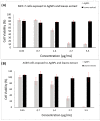Green Synthesis of Silver Nanoparticles Using Jacobaea maritima and the Evaluation of Their Antibacterial and Anticancer Activities
- PMID: 38003704
- PMCID: PMC10671674
- DOI: 10.3390/ijms242216512
Green Synthesis of Silver Nanoparticles Using Jacobaea maritima and the Evaluation of Their Antibacterial and Anticancer Activities
Abstract
Much attention has been gained on green silver nanoparticles (green-AgNPs) in the medical field due to their remarkable effects against multi-drug resistant (MDR) microorganisms and targeted cancer treatment. In the current study, we demonstrated a simple and environment-friendly (i.e., green) AgNP synthesis utilizing Jacobaea maritima aqueous leaf extract. This leaf is well-known for its medicinal properties and acts as a reducing and stabilizing agent. Nanoparticle preparation with the desired size and shape was controlled by distinct parameters; for instance, temperature, extract concentration of salt, and pH. The characterization of biosynthesized AgNPs was performed by the UV-spectroscopy technique, dynamic light scattering, scanning electron microscopy, X-ray diffraction, and Fourier-transform infrared. The successful formation of AgNPs was confirmed by a surface plasmon resonance at 422 nm using UV-visible spectroscopy and color change observation with a particle size of 37± 10 nm and a zeta potential of -10.9 ± 2.3 mV. SEM further confirmed the spherical size and shape of AgNPs with a size varying from 28 to 52 nm. Antibacterial activity of the AgNPs was confirmed against all Gram-negative and Gram-positive bacterial reference and MDR strains that were used in different inhibitory rates, and the highest effect was on the E-coli reference strain (MIC = 25 μg/mL). The anticancer study of AgNPs exhibited an IC50 of 1.37 μg/mL and 1.98 μg/mL against MCF-7 (breast cancer cells) and A549 (lung cancer cells), respectively. Therefore, this green synthesis of AgNPs could have a potential clinical application, and further in vivo study is required to assess their safety and efficacy.
Keywords: Jacobaea maritima; antibacterial; anticancer; green synthesis; silver nanoparticles.
Conflict of interest statement
The authors declare that there are no conflict of interest.
Figures







Similar articles
-
Green Synthesis and Characterization of Silver Nanoparticles Using Zingiber officinale Extracts to Investigate Their Antibacterial Potential.Int J Nanomedicine. 2024 Dec 11;19:13319-13338. doi: 10.2147/IJN.S475656. eCollection 2024. Int J Nanomedicine. 2024. PMID: 39679248 Free PMC article.
-
Biomedical Potentialities of Taraxacum officinale-based Nanoparticles Biosynthesized Using Methanolic Leaf Extract.Curr Pharm Biotechnol. 2017;18(14):1116-1123. doi: 10.2174/1389201019666180214145421. Curr Pharm Biotechnol. 2017. PMID: 29446732
-
A Potent and Safer Anticancer and Antibacterial Taxus-Based Green Synthesized Silver Nanoparticle.Int J Nanomedicine. 2020 May 28;15:3791-3801. doi: 10.2147/IJN.S251174. eCollection 2020. Int J Nanomedicine. 2020. PMID: 32547028 Free PMC article.
-
An overview of green synthesized silver nanoparticles towards bioactive antibacterial, antimicrobial and antifungal applications.Adv Colloid Interface Sci. 2024 Jan;323:103053. doi: 10.1016/j.cis.2023.103053. Epub 2023 Nov 26. Adv Colloid Interface Sci. 2024. PMID: 38056226 Review.
-
Bioinspired and Green Synthesis of Silver Nanoparticles for Medical Applications: A Green Perspective.Appl Biochem Biotechnol. 2024 Jun;196(6):3636-3669. doi: 10.1007/s12010-023-04719-z. Epub 2023 Sep 5. Appl Biochem Biotechnol. 2024. PMID: 37668757 Free PMC article. Review.
Cited by
-
Green Synthesis of Silver Oxide Nanoparticles from Mauritia flexuosa Fruit Extract: Characterization and Bioactivity Assessment.Nanomaterials (Basel). 2024 Nov 22;14(23):1875. doi: 10.3390/nano14231875. Nanomaterials (Basel). 2024. PMID: 39683263 Free PMC article.
-
Biosynthesis of silver nanoparticles from plant extracts: a comprehensive review focused on anticancer therapy.Front Pharmacol. 2025 May 14;16:1600347. doi: 10.3389/fphar.2025.1600347. eCollection 2025. Front Pharmacol. 2025. PMID: 40438589 Free PMC article. Review.
References
-
- Pungle R., Nile S.H., Makwana N., Singh R., Singh R.P., Kharat A.S. Green Synthesis of Silver Nanoparticles Using the Tridax procumbens Plant Extract and Screening of Its Antimicrobial and Anticancer Activities. Oxidative Med. Cell. Longev. 2022;2022:9671594. doi: 10.1155/2022/9671594. - DOI - PMC - PubMed
-
- Sibuyi N.R.S., Moabelo K.L., Meyer S., Skepu A., Onani M.O., Madiehe A.M., Meyer M. Nanotechnology-Based Strategies for Treatment of Obesity, Cancer and Anti-microbial Resistance: Highlights of the Department of Science and Innovation/Mintek Nanotechnology Innovation Centre Biolabels Research Node at the University of the Western Cape. Appl. Sci. 2022;12:10512. doi: 10.3390/app122010512. - DOI
MeSH terms
Substances
Grants and funding
LinkOut - more resources
Full Text Sources

